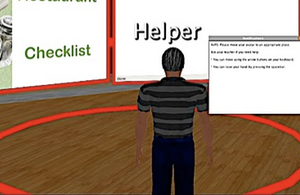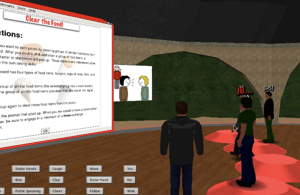
 iSocial
iSocial
iSocial is a design-based research project focused on developing a three-dimensional virtual learning environment (3D VLE) for teaching youth with autism spectrum disorders (ASD) to develop social competency. As a designer on the iSocial project, one of the initial projects was to work with a team to come up with designs for group spaces, or ways to facilitate grouping and appropriate social interaction for a small group that is in a large, open space.
Design Methodology
Designing in a 3D virtual learning environment, especially for the type of activities we're doing it and for the type of youth we're doing it for is quite unique. Because of this, some of our designs did not stand on the shoulders of giants, but came out of what we knew about designs or real life from other domains. However, the methodology for designing utilizes the premise of open environments for 3D virtual learning as well as attempting to design in a way to foster sociality and social collaboration. Anything that is designed in a way that stifles appropriate social interaction would be ceased.
Evaluation
Evaluation of orthotic and world designs were evaluated through the efficacy and usage tests, and often done through observational means. Does the world design and the orthotic implementation facilitate appropriate social interaction? Do they stifle social interaction by making the user frustrated or outright complain negatively? See the next section for examples on the iterations.
Iterations
 |

|
| First iteration of group spaces: rings around user |
Second iteration of group spaces: light, transparent plane on ground with pods for individual spots |
The first idea of rings around user was just that: an initial idea that came from knowing we needed to help users know where to stand and not run around during class time. However, upon its implementation it became clear that users felt that a ring, especially one so thick and bright felt uncomfortable, punitive, and claustrophobic. After several iterations, the lightweight "plane" with a transparent feel still acts in the same manner but gets entirely different reactions. The group space plane is seen as natural, non-punitive, and often goes unnoticed (which is great). Iterations of pods also came into play through how they are arranged. The arrangement of the pods affect the sociality of the group. If the pods are arranged in a line, then the users just stare at the teacher and the PDF Viewer or object; however, if the pods are turned in a half-circle (or partial circle), then users can see each other and it facilitates social interaction, a key component to iSocial.
